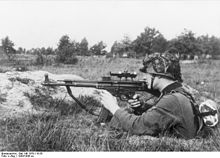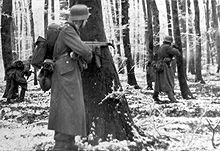- StG 44
-
"MP 43" redirects here. For the Microsoft MPEG-4 Video Codec V3, see Windows Media Video#Versions.
Sturmgewehr 44 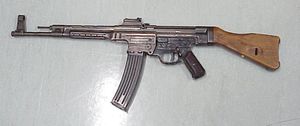
StG44Type Assault rifle Place of origin  Nazi Germany
Nazi GermanyService history In service September 1943–May 1945 (Nazi Germany) Used by See Users Wars World War II, appeared in post-1945 conflicts around the world Production history Designed 1942 Manufacturer C. G. Haenel Waffen und Fahrradfabrik
CITEFAProduced September 1943 Number built 425,977 Specifications Weight 4.62 kg (10.2 lb) with empty magazine[1] 5.22 kg (11.5 lb) with loaded magazine[2] Length 940 mm (37 in) Barrel length 419 mm (16.5 in) Cartridge 8x33mm Kurz (aka. 7.9mm Kurz or Pistolenpatrone 43) Action Gas-operated, tilting bolt Rate of fire 550-600 rounds/min Muzzle velocity 685 m/s (2,247 ft/s) Effective range 400 m (Semi-Automatic), 300 m (Full-Automatic) Maximum range 800 m Feed system 30-round detachable box magazine Sights Adjustable sights, rear: V-notch; front: hooded post The StG 44 (Sturmgewehr 44, literally :"storm (or assault) rifle (model of 19)44") was an assault rifle developed in Nazi Germany during World War II and was the first of its kind to see major deployment, considered by many historians to be the first modern assault rifle[3] (the first assault rifle being the Fedorov Avtomat). It is also known under the designations MP 43 and MP 44 (Maschinenpistole 43, Maschinenpistole 44 respectively), which denote earlier development versions of the same weapon with some differences like a different butt end, muzzle nut, shape of the front sight base or with a unstepped barrel, all only visible with close inspection.
Contents
Description
MP 43, MP 44, and StG 44 were different designations for what was essentially the same rifle, with minor updates in production. The variety in nomenclatures resulted from the complicated bureaucracy in Nazi Germany. Developed from the Mkb 42(H) "machine carbine", the StG44 combined the characteristics of a carbine, submachine gun and automatic rifle. StG is an abbreviation of Sturmgewehr. The name was chosen for propaganda reasons and literally means "storm rifle" as in "to storm (i.e. "assault") an enemy position". After the adoption of the StG 44, the English translation "assault rifle" became the accepted designation for this type of infantry small arm.
The rifle was chambered for the 8x33mm Kurz cartridge, also known as 7.9 mm Kurz. This shorter version of the German standard (8x57mm IS) rifle round, in combination with the weapon's selective-fire design, provided a compromise between the controllable firepower of a submachine gun at close quarters with the accuracy and power of a Karabiner 98k bolt action rifle at intermediate ranges. While the StG44 had less range and power than the more powerful infantry rifles of the day, Wehrmacht studies had shown that most combat engagements occurred at less than 300 m, with the majority within 200 m. Full-power rifle cartridges were excessive for the vast majority of uses for the average soldier. Only a trained specialist, such as a sniper, could make full use of the standard rifle round's range and power.
The StG 44's receiver was made of heavy stamped and welded steel as were other contemporary arms such as the MP 40 and MG 42. This made for a fairly heavy rifle, especially one firing an intermediate-power cartridge. Difficulties with fabrication, the need to use available non-priority steels, and the exigencies of war resulted in a heavy receiver. U.S. military intelligence criticized the weight of the weapon along with the inclusion of the fully automatic feature which it considered "ineffectual for all practical purposes", convinced that full automatic fire with StG 44 was permitted in emergencies only.[4] This was a misinterpretation of the manual however, as the German manual states that automatic fire was "advised only in emergencies", this was mainly to make sure that the regular soldier didn't unnecessarily waste his ammunition spraying at targets, but instead fired in short accurate bursts to achieve maximum accuracy and effect; the StG could easily and safely be used in full automatic mode. The British were also critical saying that the receiver could be bent and the bolt locked up by the mere act of knocking a leaning rifle onto a hard floor.[5] Many of these criticisms are more a testimonial of the Allied aversion rather than an accurate view of the weapon's characteristics which were proven highly effective during combat in the war.[6]
To its credit, it was the first successful weapon of its class, and the concept had a major impact on modern infantry small arms development. By all accounts, the StG 44 fulfilled its role admirably, particularly on the Eastern Front, offering a greatly increased volume of fire compared to standard infantry rifles. In the end, it came too late to have a significant effect on the outcome of the war.[7]
History
Background
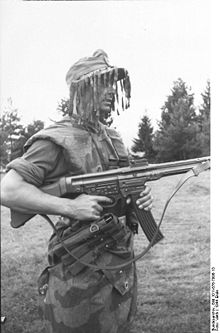 A German infantryman wearing "splinter" camouflage and a ghillie cap.
A German infantryman wearing "splinter" camouflage and a ghillie cap.
At the start of the Second World War, German infantry were equipped with weapons comparable to those of most other military forces. A typical infantry unit was equipped with a mix of bolt action rifles and some form of light or medium machine guns. One difference from other armies was the emphasis on the machine gun as the primary infantry weapon. In contrast, allied doctrine centered around the rifleman, with machine guns employed as support and point-defense weapons. German units tended to be machine gun "heavy", carrying more ammunition for the machine gun than for the rifles, using belt ammunition for their more modern section-level weapons to maintain a higher rate of fire, and generally thinking of the rifle as a support weapon. Although newer rifle designs had been studied on several occasions, the infantry squad primary centered around the machine gun.[citation needed]
One problem with this mix was that the standard rifles were too large to be effectively used by mechanized and armored forces, where they were difficult to maneuver in the cramped spaces of an armored vehicle. Submachine guns such as the MP 28, MP 38, and MP 40 were issued to augment infantry rifle use and increase individual firepower, but suffered from a distinct lack of range and accuracy beyond 100 m. A small fast-firing weapon would have been useful in this role, but again the need did not seem pressing.
The issue arose once again during the invasion of the Soviet Union. The Red Army had been in the process of replacing its own bolt action rifles in the immediate pre–war era. Increasing numbers of semi-automatic Tokarev SVT-38 and SVT-40s were reaching Red Army units, though issue was generally restricted to elite units and non-commissioned officers. Submachine guns were extremely widespread, and issued on a far larger scale; some Soviet rifle companies were completely equipped with PPSh-41 submachine guns.[8]
This experience with high volumes of hand-held automatic 'assault' fire forced German commanders to rethink their small arms requirements. The German army had been attempting to introduce semi-automatic weapons of their own, notably the Gewehr 41, but these early rifles proved troublesome in service, and production was insufficient to meet forecast requirements. Several attempts had been made to introduce lightweight machine guns or automatic rifles for these roles, but invariably recoil from the powerful 8x57mm JS round made them too difficult to control in automatic fire.
The German solution was to use a round of intermediate power, between that of a full-power rifle cartridge and pistol ammunition. Experiments with several such intermediate rounds had been going on since the 1930s, but had been constantly rejected for use by the army. By 1941, it was becoming clear that action needed to be taken, and one of the experimental rounds, the Polte 8x33mm Kurzpatrone ("short cartridge") was selected. To minimize logistical problems, the Mauser 8 mm rifle cartridge was used as the basis for the final 7.9mm Kurz intermediate round, which also utilized an aerodynamic spitzer rifle bullet design.
MKb 42
 The early Haenel MKb 42(H), the precursor to the MP 43/44. This example belongs to the Springfield Armory National Historic Site.
The early Haenel MKb 42(H), the precursor to the MP 43/44. This example belongs to the Springfield Armory National Historic Site.
Contracts for rifles firing the 7.9mm Kurz round were sent to both Walther and Haenel (whose design group was headed by Hugo Schmeisser), who were asked to submit prototype weapons under the name Maschinenkarabiner 1942 (MKb 42, literally "machine (ie. fully automatic) carbine"). Both designs were similar, using a gas-operated action, with both semi-automatic and fully automatic firing modes.
The original prototype of Haenel's design, the MKb 42(H), fired from an open bolt and used a striker for firing. The receiver and trigger housing with pistol grip were made from steel stampings, which were attached to the barrel assembly on a hinge, allowing the weapon to be folded open for quick disassembly and cleaning. The Haenel design proved superior to Walther's MKb 42(W), and the army then asked Haenel for another version incorporating a list of minor changes designated MKb 42(H). One was to include lugs for mounting a standard bayonet, another to change the pitch of the rifling. A production run of these modified versions was sent to the field in November 1942, and the users appreciated it with a few reservations. Another set of modifications added a hinged cover over the ejection port to keep it clean in combat, and rails to mount a telescopic sight. A run of these modified MKb 42(H)s in late 1942 and early 1943 produced 11,833 guns for field trials.
Ultimately it was recommended that a hammer firing system operating from a closed bolt similar to Walther's design be incorporated. The gas expansion chamber over the barrel was deemed unnecessary, and was removed from successive designs, as was the underbarrel bayonet lug.
MP 43, MP 44, StG 44
As work moved forward to incorporate this new firing system, development temporarily came to halt when Hitler suspended all new rifle programs due to administrative infighting within the Third Reich, ordered that more, newer submachine guns were to be built and strongly disagreed with the use of the new ammunition. To keep the MKb 42(H) alive, the Waffen Amt (Armament Office) re-designated it into the Maschinenpistole 43 (MP 43) and making a few improvements, billed as an upgrade to existing submachine guns.
This deception was eventually discovered by Adolf Hitler who again had the program halted. In March 1943, he permitted it to recommence for evaluation purposes only. Running for six months until September 1943, the evaluation produced positive results and Hitler allowed the MP 43 program to continue and in order to make mass production possible. The first MP 43 were distributed to the Waffen-SS, and in October 1943, some especially to the 93rd Infantry Division on the Eastern Front when war was raging. Production and distribution continued to different troops until April 1944, where Hitler ordered it re-designated MP 44 with adding minor updates after taking some interest in the weapon tests. In July 1944, at a meeting of the various army heads about the Eastern Front, when Hitler asked what they needed, a general exclaimed, "More of these new rifles!". This caused some confusion (Hitler's response is reputed to have been "What new rifle?"), but once Hitler was given a chance to see and test-fire the MP 44, he was impressed and gave it the title Sturmgewehr. Seeing the possibility of a propaganda gain, the rifle was again renamed as the StG 44, to highlight the new class of weapon it represented, translated "Storm (Assault) rifle, model 1944", thereby introducing the term.[9]
Seeking to enhance the propaganda value of the new weapon, Hitler ordered it re-designated StG44 (Assault Rifle, Model 1944), giving the rifle its own class. Production soon began with the first batches of the new rifle being shipped to troops on the Eastern Front. A total of 425,977 StG44s were produced by the end of the war and work had commenced on a follow-on rifle, the StG45. Among the attachments available for the StG44 was the Krummlauf, a bent barrel that permitted firing around corners. These were most commonly made with 30° and 45° bends.
By the end of the war, some 425,977 StG 44 variants of all types were produced. The assault rifle proved a valuable weapon, especially on the Eastern front, where it was first deployed. A properly trained soldier with a StG44 had an improved tactical repertoire, in that he could effectively engage targets at longer ranges than with an MP 40, but be much more useful than the Kar 98k in close combat, as well as provide covering fire like a light machine gun. It was also found to be exceptionally reliable in the extreme cold of the Russian winter. The StG44's rate of fire varied between 500 and 600 rpm.
The StG 44 was an intermediate weapon for the period; the muzzle velocity from its 419 mm (16.5 in) barrel was 685 m/s (2,247.4 ft/s), compared to 760 m/s (2,493 ft/s) of the Karabiner 98k, 744 m/s (2,440.9 ft/s) of the British Bren, 600 m/s (1,968.5 ft/s) of the M1 carbine, and 365 m/s (1,197.5 ft/s) achieved by the MP40.
One unusual addition to the design was the Krummlauf; a bent barrel attachment for rifles with a periscope sighting device for shooting around corners from a safe position. It was produced in several variants: a "I" version for infantry use, a "P" version for use in tanks (to cover the dead areas in the close range around the tank, to defend against assaulting infantry), versions with 30°, 45°, 60° and 90° bends, a version for the StG 44 and one for the MG 42. Only the 30° "I" version for the StG 44 was produced in any numbers. The bent barrel attachments had very short lifespans – approx. 300 rounds for the 30° version, and 160 rounds for the 45° variant. The 30° model was able to achieve a 35x35 cm grouping at 100 m.[10]
The Sturmgewehr was also at times fitted with the Zielgerät 1229 infrared aiming device, also known by its codename Vampir ("vampire"). This device consisted of a large scope, rather like modern starlight scopes, and a large infra-red lamp on top, the scope being able to pick up the infra-red that would be invisible to the naked eye.
A primary use of the MP44/StG44 was to counter the Soviet PPS and PPSh-41 submachine guns, which used the 7.62x25mm Tokarev round. These cheap, mass-produced weapons used a 71-round drum magazine or 35-round box magazine and though shorter-ranged than the Kar98k rifle, were more effective weapons in close-quarter engagements. The StG 44, while lacking the range of the Kar 98k, had a considerably longer range than the PPS/PPSh submachine guns, a comparable rate of fire, an ability to switch between a fully automatic and a default semi-automatic fire mode and surprising accuracy. Furthermore the StG44's inline design gave it controllability even on full-auto. In short the StG44 provided the individual user with unparalelled firepower compared to that of all earlier handheld firearms, waranting other countries to soon embrace the assault rifle concept.
Late prototypes
 The Gerät 06 ("instrument or device 06") prototype. An attempt to further simplify the MP 43/44 and StG 44 series of weapons. The pictured example is incomplete; captured and evaluated at Aberdeen Proving Ground after the war.
The Gerät 06 ("instrument or device 06") prototype. An attempt to further simplify the MP 43/44 and StG 44 series of weapons. The pictured example is incomplete; captured and evaluated at Aberdeen Proving Ground after the war.
In a somewhat unrelated development, Mauser continued design work on a series of experimental weapons in an effort to produce an acceptable service-wide rifle for the short cartridge system. One of these prototypes, a product of the engineers at the Light Weapon Development Group (Abteilung 37) at Oberndorf, was the MKb Gerät 06 (Maschinenkarabiner Gerät 06 or "machine carbine instrument 06") first appearing in 1942. This gun used a unique gas piston-delayed roller-locked action derived from the short recoil operation of the MG 42 machine gun but with a fixed barrel and gas system. It was realized that with careful attention to the mechanical ratios, the gas system could be omitted. The resultant weapon, the Gerät 06(H) was supposedly slated for adoption by the Wehrmacht as the StG 45(M). The operating principle lived on in postwar designs from CEAM/AME, CETME, and most famously, Heckler & Koch.
Towards the end of the war, there were last-ditch efforts to develop cheap so-called Volksgewehr rifles in the 8x33mm caliber. One of these, the VG 1-5 (Volkssturmgewehr 1-5), used a gas-delayed blowback action based on the Barnitzke system, whereby gas bled from the barrel near the chamber created resistance to the rearward impulse of the operating parts, which ceases when the projectile leaves the muzzle, allowing the operating parts to be forced rearward by the residual pressure of the cartridge case. This principle has been used most successfully in the P7 pistol.
Post-war
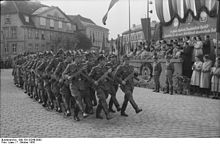 Officers of the East German Volkspolizei parading through the streets of Neustrelitz in 1955. The StG 44 remained in service with the organization until the early 1960s.
Officers of the East German Volkspolizei parading through the streets of Neustrelitz in 1955. The StG 44 remained in service with the organization until the early 1960s.
Generally accepted as the world's first assault rifle, the StG44's effect on post-war arms design was wide-ranging, as evidenced by Mikhail Kalashnikov's AK-47, and later in the U.S. M16 and its variants. The Soviet Union was quick to adopt the assault rifle concept. The AK-47 used a similar-sized intermediate round and followed the design concept, but was mechanically different.[11]
After World War II, many Western countries continued using their existing full-caliber rifles. Although the 7.62x51mm NATO round adopted post-war was still a full-power cartridge, the trend towards the adoption of less powerful rounds was already underway in the West. For example, the M1 Garand had initially been developed for the .276 Pedersen (7 mm) round, a cartridge less powerful than the standard .30-06 Springfield. The U.S. Army's adoption of the M1 carbine in 1941 proved the utility of a small, handy, low-powered rifle that required little training to use effectively. Franchi of Italy based the actions of both the LF-58 carbine and the LF-59 battle rifle on the StG-44.[12]
America and, later, NATO developed assault rifles along a roughly similar path by at first adding selective-fire capability in a reduced power, full-caliber cartridge. The Soviet Union lightened the AK-47 and introduced the AKM. America developed the concept of small-caliber, high-velocity (SCHV) bullets and further reduced the weight of their firearms with the introduction of the M16. The Soviets followed suit with the introducing the SCHV AK-74 rifle.
As for the Sturmgewehr itself, it remained in use with the East German Nationale Volksarmee with the designation MPi.44 until it was eventually replaced with variants of the AK-47 assault rifle. The Volkspolizei used it until approximately 1962 when it was replaced by the PPSh-41. Other countries to use the StG 44 after World War II included the Czechoslovak Socialist Republic[13] and the Socialist Federal Republic of Yugoslavia,[14] where units as the 63rd Paratroop Battalion were equipped with it until the 1980s,[15] when the rifles were ultimately transferred to Territorial Defense reserves or sold to friendly regimes in the Middle East and Africa.
Argentina manufactured their own trial versions of the StG 44 made by CITEFA in the late 1940s and early 1950s,[16][17] but instead adopted the FN FAL in 1955, because it used the then more modern, common and powerful 7.62x51mm NATO round, that also lacked connections with the Third Reich.[18]
New semi-automatic reproductions of the MKb 42(H), MP 43/1, and StG 44 are being manufactured in Germany today by HZA Kulmbach GmbH[19] in the original 7.92x33mm Kurz chambering.
Users
 Argentina (trial purposes only)[17][20]
Argentina (trial purposes only)[17][20] Czechoslovakia[7]
Czechoslovakia[7] Kingdom of Hungary[21]
Kingdom of Hungary[21] East Germany
East Germany Nazi Germany[22]
Nazi Germany[22] Yugoslavia[23]
Yugoslavia[23]
Non state groups
After World War II, the Soviet Union and other Eastern Bloc states supplied client regimes and guerrilla movements with captured German arms such as the StG 44 along with newly manufactured or repackaged 7.92x33mm ammunition. French forces discovered many in Algeria and determined the origin to be from Czechoslovakia. Examples also found their way into the hands of the Vietcong during the Vietnam War, and the PLO. It is still used in very limited numbers by militia forces in the Middle East[24] as well as some countries in the Horn of Africa. StG 44s have been confiscated from militia groups by U.S. forces in Iraq.
See also
- Calzada Bayo CB-57
- HIW VSK
- Wimmersperg Spz-kr
References
- ^ http://i225.photobucket.com/albums/dd297/armeiro1/1325123.jpg
- ^ Second World War History[dead link]
- ^ Ed Ezell, Ian Hogg, Chris Bishop, John Weeks, Vincent DiMaio, David Westwood, and WHB Smith.
- ^ "Machine Carbine Promoted," Tactical and Technical Trends, No. 57, April 1945.
- ^ Shore, C. (Capt.), With British Snipers to the Reich, Samworth Press, 1948
- ^ , Daniel D. Musgrave, German weapons of War: Infantry weapons of the Third Reich, MOR Associates, 1985
- ^ a b Bishop, Chris (1998), The Encyclopedia of Weapons of World War II, New York: Orbis Publiishing Ltd, ISBN 0-7607-1022-8
- ^ Weeks, John, World War II Small Arms, Galahad Books, 1979
- ^ "Tactical and Technical Trends, No. 57, April 1945, War Department". Lonesentry.com. 2007-05-10. http://www.lonesentry.com/articles/ttt07/stg44-assault-rifle.html. Retrieved 2011-09-17.
- ^ "Lexikon der Wehrmacht: Sturmgewehre (Encyclopedia of the German Army: Assault Rifles)". Wehrmacht. January 11, 2007. http://www.lexikon-der-wehrmacht.de/Waffen/sturmgewehre.htm.
- ^ Joly, Elena; Kalashnikov, Mikhail (2006), The Gun That Changed the World, Cambridge: Polity, ISBN 9780745636924, http://search.barnesandnoble.com/The-Gun-That-Changed-the-World/Elena-Joly/e/9780745636924/?itm=1
- ^ "Franchi LF58 / LF59 - Guns Review / American Rifleman - 1971". Exordinanza.net. http://www.exordinanza.net/reprint/Franchi_LF58-59.htm. Retrieved 2011-09-17.
- ^ "Valka.cz site". Forum.valka.cz. 2008-07-22. http://forum.valka.cz/viewtopic.php/t/11593. Retrieved 2011-09-17.
- ^ "1966 photograph of JNA unit with StG44s". Rides.webshots.com. http://rides.webshots.com/photo/1354334992070697302rZYHaM. Retrieved 2011-09-17.
- ^ "Svetski Rat article on postwar Yugoslavian use of StG44". Svetskirat.net. http://www.svetskirat.net/naoruzanje/stg44.htm. Retrieved 2011-09-17.
- ^ (Spanish)Museo de Armas de La Nacion
- ^ a b *Julio S. Guzmán, Las Armas Modernas de Infantería, Abril de 1953
- ^ Argentinian Military ww2incolor.com forum post
- ^ "Sport-Systeme Dittrich website". http://www.ssd-weapon.com/engl_web/produkte_en/bd44_en/bd44_en.htm. Retrieved 2008-06-06.[dead link]
- ^ [1][dead link]
- ^ Rada, Tibor (2001) (in Hungarian). A Magyar Királyi Honvéd Ludovika Akadémia és a Testvérintézetek Összefoglalt Története (1830-1945). II. Budapest: Gálos Nyomdász Kft. p. 1114. ISBN 963-85764-3-X.
- ^ Fleming, David. Weapons of the Waffen SS. Zenith Press. p. 27. ISBN 0760315949.
- ^ Maxim Popenker (2005). p. 107. ISBN 1861267002.
- ^ "Pro-Lebanese Forces website". http://www.lebaneseforces.com/wassaultrif.asp. Retrieved 2008-06-06.
External links
- Modern Firearms
- MKb42(W)
- MKb42(W) test fired at the Royal Military Academy Sandhust
- StG 44 on GunsTribune
German firearms and light weapons of World War IISide arms (Pistolen) Mauser C96 · Luger · Walther P38 · Walther PP and PPK · Sauer 38H · Mauser HSc · Dreyse M1907 Pistol · VolkspistoleRifles & carbines (Gewehre & Karabiner) Karabiner 98k · G 24(t) · G 33/40(t) · G 98/40 · Gewehr 41 · Gewehr 43/Karabiner 43 · MP 43/MP 44/StG 44 · FG 42 · M30 Luftwaffe drilling · StG 45(M) · VG 1-5 · Wimmersperg Spz-krSubmachine guns (Maschinenpistolen) Machine guns & other larger weapons MG 08 · VMG-27 · Schwarzlose MG M.07/12 · MG 13 · MG 15 · MG 26 · MG 30 · MG 34 · MG 42 · MG 45 · IMG 28 · MG 35/36A · Faustpatrone · Raketen-Panzerbüchse 43 · Panzerfaust · Panzerschreck · Fliegerfaust/Luftfaust · Flammenwerfer 35 · Einstossflammenwerfer 46 · Panzerbüchse 39 · Solothurn S-18/1000Mortars (Granatwerfer) Grenades (Granaten) Notable foreign-made infantry weapons German-made cartridges used by the Wehrmacht 8×57mm IS · 7.63×25mm Mauser · 8x33mm Kurz · 7.65×22mm Parabellum · 9×19mm Parabellum · 13.2×92mmSR · 7.92×94mmCategories:- 8 mm firearms
- Assault rifles
- World War II German infantry weapons
- German guns
Wikimedia Foundation. 2010.

